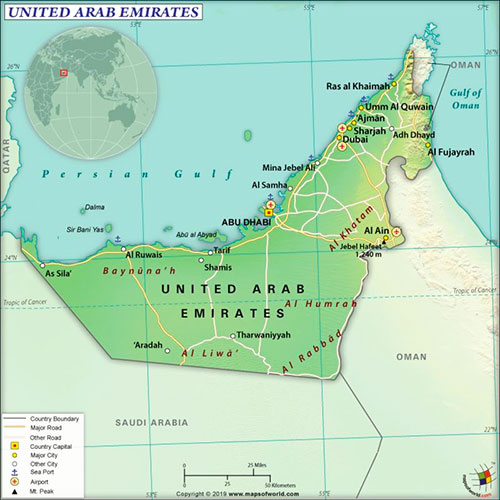The United Arab Emirates:

A Journey Through Time
The earliest beginnings of the region's history trace back to 6000 BC when it was inhabited by nomadic tribes relying on hunting and agriculture for their livelihood. This era was characterized by pottery, as revealed by archaeological excavations.
Foundation of the United Arab Emirates:
The United Arab Emirates (UAE) is a federal state established on December 2, 1971, consisting of seven emirates: Abu Dhabi, Dubai, Sharjah, Ajman, Umm Al-Quwain, Ras Al khaimah, and Fujairah.
UAE is one of the most deeply rooted countries in modern history, known for its leadership in economic, social, and security stability. It has maintained its stability amidst the regional turmoil for many decades. The federal state authorities consist of the Supreme Council of the Union, including the President of the Union and his Deputy, the Cabinet, the Federal National Council, and the Federal Judiciary.
Official Working Hours:
Monday-Thursday ( 07:30 to 15:30 )
Friday ( 07:30 to 12:00 )

National Flag:
Three equal and parallel horizontal lines with green at the top, white in the middle, and black at the base, in addition to a vertical red strip on the side of the flag pole.

Location :
The UAE is located in the southeast of the Arabian Peninsula, and its map takes a triangular shape. Its coasts stretch from the southern and southeastern edges of the Arabian Gulf to part of the western coasts of Gulf of Oman, granting the country a strategic location across the western entrances of the Strait of Hormuz.
Area :
Approximately 82,880 sq km, with Abu Dhabi covering 87% of the total area of the country. The coastline of the UAE is over 1318 km long, thanks to ongoing urban projects.
Climate:
The UAE is located in the arid tropical region that extends across Asia and North Africa and is affected by oceanic climate due to its location along the Arabian Gulf and Gulf of Oman coasts which is connected to the Red Sea via the Strait of Bab Al-Mandab.
The country's climate is characterized by high heat and humidity during summer, with temperatures ranging between 35-41°C, and humidity levels between 60-100%. The coastal and inland desert climates and highlands in the country vary significantly.
During the winter, the weather is moderate, with temperatures ranging between 18-25°C, with lowest humidity levels, varying rainfall rates, especially in the eastern mountain range, which is generally colder.
Population:
The Emirati people are characterized by adherence to righteous moral values and strong attachment to inherited customs and traditions.
At the same time, they have an ambition to build a prosperous future that combines the spirit of authenticity and modernity.
The Emiratis enjoy a high standard of living, advanced education, comprehensive healthcare, and social care.
The UAE government is making significant efforts to develop national human resources, stimulate the role of women, and empower them to hold prestigious positions in society and job market. According to the Federal Competitiveness and Statistics Center, the total population of the UAE, including citizens and residents, was 9,282,410 in 2020.
Historical Events:
The Portuguese were among the first Europeans to arrive at the Arabian Peninsula in 1498, thanks to the Portuguese sailor Vasco da Gama. They soon dominated the spice and pepper trade before facing strong resistance from the locals in the 17th century.
The loss of the Strait of Hormuz in 1622 marked the arrival of the Dutch and English into the Middle Eastern markets. By 1720, British commercial activities in the Gulf flourished so they sought to strengthen their naval power to protect trade ports with India.
With the establishment of the Qawasim power in Musandam and the northern and eastern regions of the Arabian Gulf, conflict with the British began.
A series of agreements between Britain and the Gulf sheikhdoms from 1820 to 1853 maintained the safety of the maritime route, leading to the naming of the region as the Trucial Coast Emirates.
By the end of the nineteenth century, Britain obtained oil concession commitments from the Trucial Coast leaders. As a result, it became necessary to define and draw the internal borders between the emirates of the Trucial Coast.
In 1968, Britain announced its intention to withdraw from the Gulf by the end of 1971, which indeed happened on November 30, 1971.
The UAE was formerly known as "Al Ghabraa" and then "Oman Coast" due to its connection to the Sultanate of Oman.
The region has been inhabited by prominent tribes including Bani Yas, a tribe affiliated with Yas bin Amer, and from this tribe the Al Nahyan rulers of Abu Dhabi and the Al Maktoum rulers of Dubai descend.
It inhibited also by Al Qawasim, tribe that rules Ras Al Khaimah and Sharjah, Al Nuaimi ruling Ajman, Al Sharqi ruling Fujairah, and the Al Ali tribe to which the rulers of Umm Al-Quwain belong.
Al Samha meeting.
Issuance of the UAE's interim constitution.
Establishment of the UAE and election of Sheikh Zayed bin Sultan Al Nahyan as President and Sheikh Rashid bin Saeed Al Maktoum as Vice President; appointment of Sheikh Maktoum bin Rashid Al Maktoum as Prime Minister.
UAE joins the Arab League.
Ras Al Khaimah requests to join the UAE.
Establishment of the Federal National Council.
First session of the Federal National Council.
UAE hosts its first Gulf summit.

